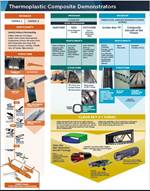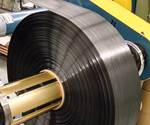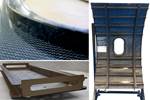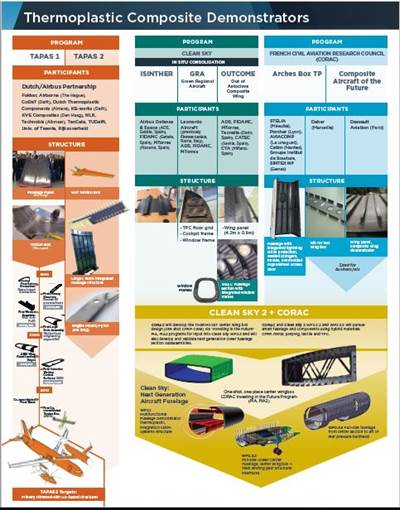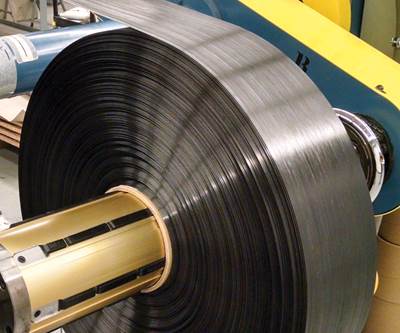First Toray LMPAEK tape laminate for Clean Sky MECATESTERS project
KVE Composites Group and Rescoll cooperate in GKN Fokker-led project to develop micromechanical characterization of thermoplastic co-consolidated joints for aircraft fuselages
SOURCE | KVE Composites Group
The first laminate made from Toray Advanced Composites’ (Nijverdal, Netherlands) unidirectional (UD) prepreg tape made with carbon fiber-reinforced LMPAEK polymer from Victrex (Clevelys, U.K.) for the MECATESTERS Clean Sky 2 project has been autoclave processed at the ThermoPlastic composites Research Center (TPRC, Enschede, Netherlands). This is the first of many laminates that will be produced, welded and tested as part of this 30-month project (JTI-CS2-2018-CFP08-LPA-02-25) within the Clean Sky 2 Large Passenger Aircraft initiative. MECATESTERS aims to validate induction welding and conduction welding of thermoplastic composite laminates made from UD tape for industrialized aircraft applications.
Launched in April 2019, KVE Composites Group (The Hague, Netherlands) and Rescoll (Pessac, France) are working with the MECATESTERS project leader, GKN Fokker (Hoogeveen, Netherlands), to create a greater level of understanding of the micromechanical behavior of the welded interfaces for UD tape-based laminates, an understanding which is currently limited to carbon fabric-based laminates. Issues such as aging, healing, processing parameters and durability need to be investigated in greater detail in order to develop a coherent approach. This is a key step in the progression of such technologies to widespread use in the aerospace sector.
This project will investigate many aspects of thermoplastic joining using what have been identified within Clean Sky 2 as the two most promising and mature thermoplastic welding methods for aerospace carbon fiber reinforced thermoplastic composites: induction welding and conduction welding.
Induction welding was pioneered and continues to be developed by KVE Composites Group for continuous welding of aerospace structures. It is used commercially by GKN Fokker for production of Gulfstream G650 and Dassault 6X rudders and elevators and by Aviacomp for welding fuel tank access panels for the Airbus A220.
Conduction welding has been developed by GKN Fokker within the TAPAS-2 project for spot welding applications. The main aim is to evaluate and validate these two welding methods for typical fuselage thermoplastic components based on UD carbon fiber/LMPAEK tapes, and to develop a comprehensive understanding of their micromechanical behavior.
(See “Welding thermoplastic composites” and “New horizons in welding thermoplastic composites”.)
In order to reach this goal, four key objectives have been established, which will make the overall MECATESTERS project realistic and achievable within the proposed 30-month timeframe:
- Evaluate the effect of surface conditions on the welded interface
A detailed examination of different surface types will provide clear guidelines for production and maintenance with respect to the surface state.
- Examine the effects of aging on the durability of UD carbon fiber/LMPAEK parts
The evaluation of aging on the durability of UD carbon fiber/LMPAEK parts will provide valuable information to establish suggested maintenance intervals, engineering tolerances and lifetimes.
- Perform a process window comparison for welding methods
Two welding method are selected and further investigated in order to provide an industrially suitable, high-performance and high-quality solution for thermoplastic welding of UD carbon fiber/LMPAEK parts.
- Perform mechanical testing to validate welded joint performance
The MECATESTERS project will provide a detailed analysis of the microstructural behavior of welded thermoplastic assemblies in order to select and apply the most optimal joining technology.
Related Content
AGY, A+ Composites launch fiberglass thermoplastic tape line
Unidirectional S2 glass fiber reinforced with LM-PAEK and PEI boosts mechanical and thermal and sustainability properties for wrapped and layered composite applications.
Read MoreTeijin Carbon, A&P Bimax TPUD braided fabric meets scalable composites manufacturing goals
A combination of Teijin Carbon’s UD thermoplastic tapes and A&P Technology’s braided fabrics translates into a PAEK biaxial fabric with minimal crimp, high drapability and other rate-enabling qualities.
Read MoreUltrasonic welding for in-space manufacturing of CFRTP
Agile Ultrasonics and NASA trial robotic-compatible carbon fiber-reinforced thermoplastic ultrasonic welding technology for space structures.
Read MoreRead Next
Thermoplastic composite demonstrators — EU roadmap for future airframes
There is a TPC development roadmap in Europe, supported by Airbus and a variety of aerospace consortia, and involving almost every major aerostructures supplier in Europe.
Read MoreI want to say two words to you: “Thermoplastic tapes”
Thermoplastic tapes are not new to composites, but they soon will join the primary aerostructures material palette and could be their future.
Read MoreWelding thermoplastic composites
Multiple methods advance toward faster robotic welds using new technology for increased volumes and larger aerostructures.
Read More
